Investigating Toxic Leadership and Employee Retention at Apple Inc.
VerifiedAdded on 2021/01/01
|11
|3204
|116
Report
AI Summary
This report investigates the effects of toxic leadership on employee retention within organizations, specifically focusing on Apple Inc. The introduction defines toxic leadership and its adverse impacts on employee performance and retention. The literature review explores the concept of toxic leadership, its negative correlations with employee commitment and motivation, and the importance of healthy leadership. It examines the impact of toxic leadership on employee performance at Apple, including poor listening skills, lack of feedback, lack of accountability, and bad behavior modeling. The research methodology utilizes a qualitative approach. The report also analyzes the relationship between toxic leadership and employee retention, emphasizing the importance of employee satisfaction and a positive work environment. Finally, it discusses measures Apple Inc. employs to improve employee retention, such as hiring the right people, providing training, offering guidance, creating the right culture, and providing benefits and rewards. This research aims to understand how toxic leadership affects employee retention, using Apple Inc. as a practical example.
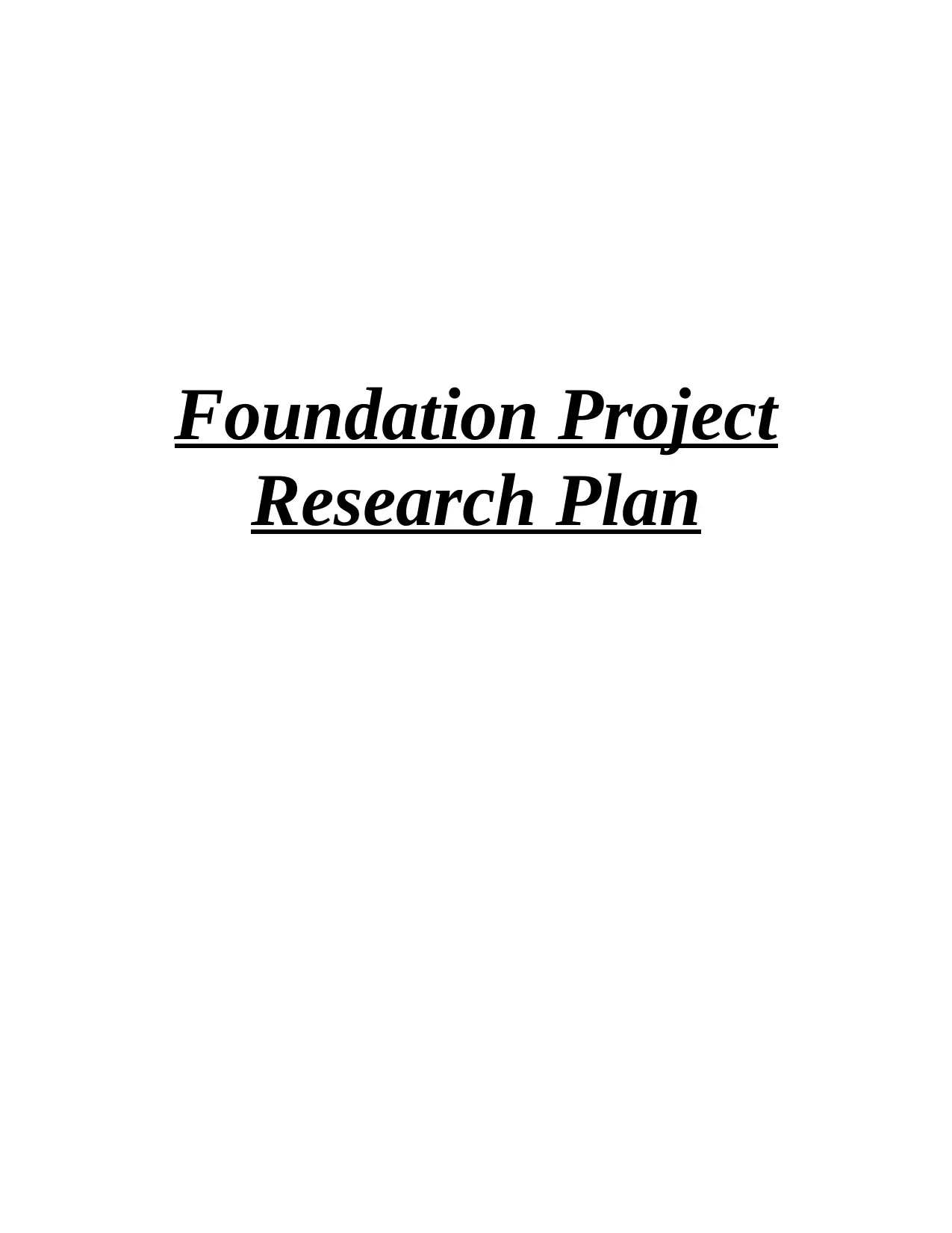
Foundation Project
Research Plan
Research Plan
Paraphrase This Document
Need a fresh take? Get an instant paraphrase of this document with our AI Paraphraser
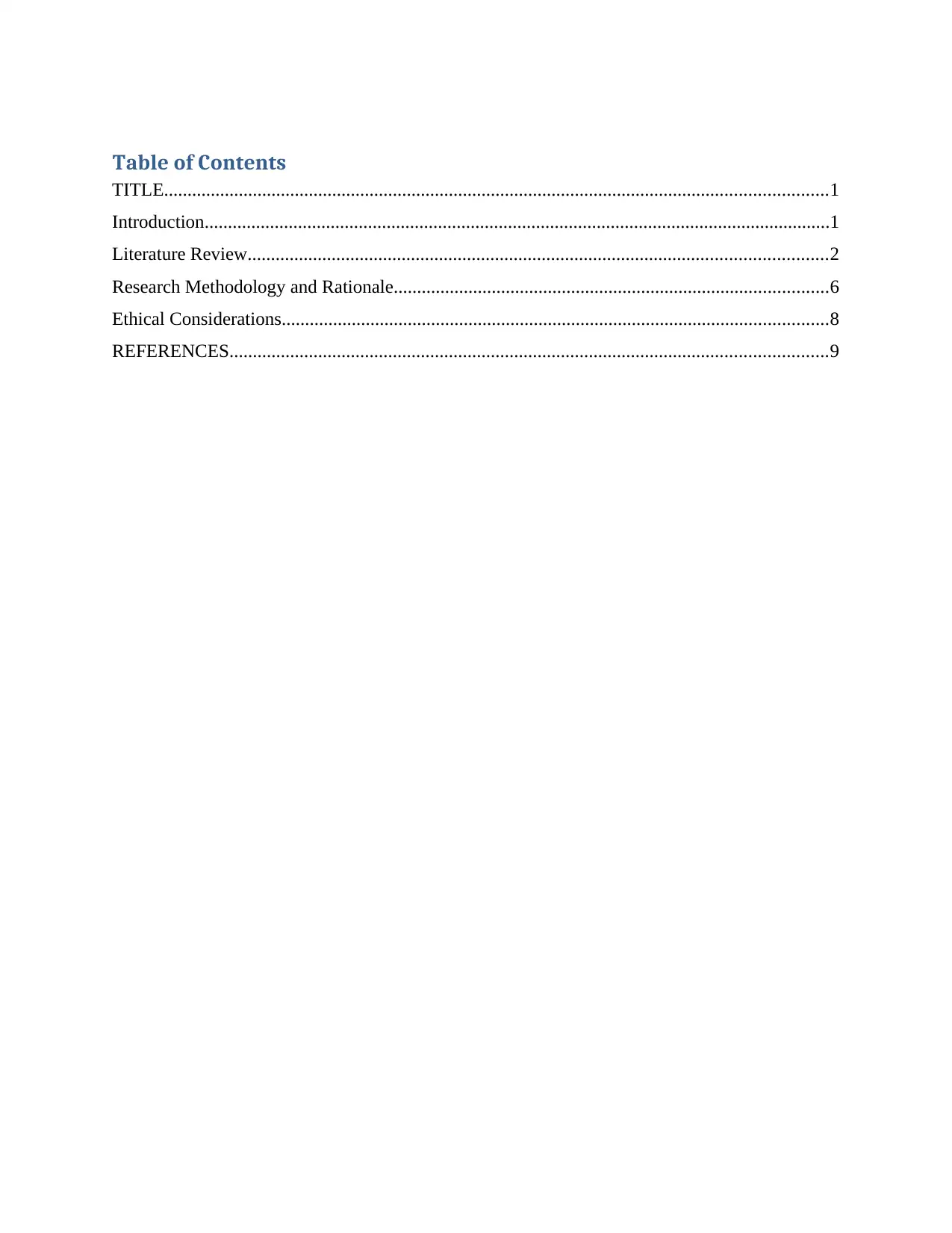
Table of Contents
TITLE..............................................................................................................................................1
Introduction......................................................................................................................................1
Literature Review............................................................................................................................2
Research Methodology and Rationale.............................................................................................6
Ethical Considerations.....................................................................................................................8
REFERENCES................................................................................................................................9
TITLE..............................................................................................................................................1
Introduction......................................................................................................................................1
Literature Review............................................................................................................................2
Research Methodology and Rationale.............................................................................................6
Ethical Considerations.....................................................................................................................8
REFERENCES................................................................................................................................9
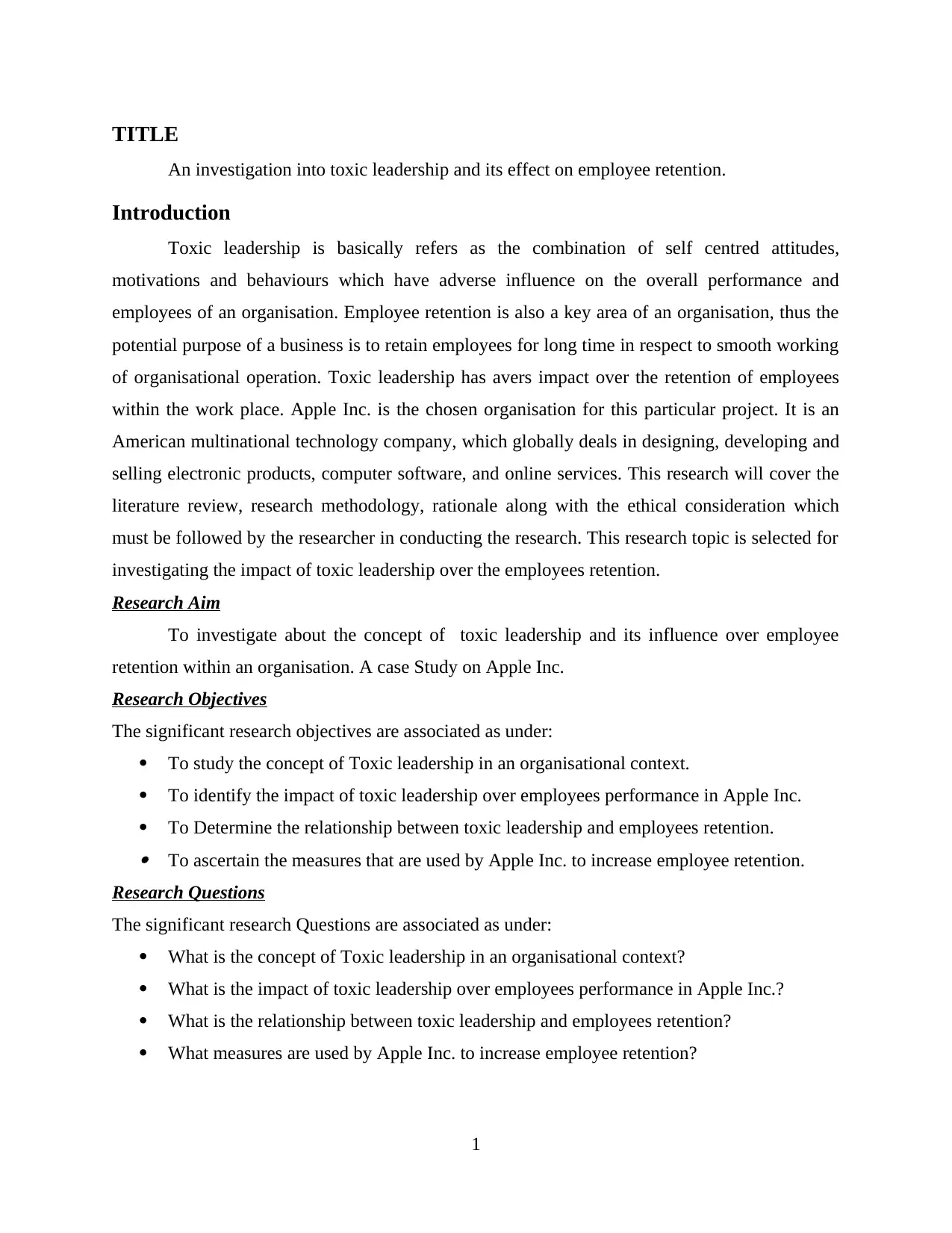
TITLE
An investigation into toxic leadership and its effect on employee retention.
Introduction
Toxic leadership is basically refers as the combination of self centred attitudes,
motivations and behaviours which have adverse influence on the overall performance and
employees of an organisation. Employee retention is also a key area of an organisation, thus the
potential purpose of a business is to retain employees for long time in respect to smooth working
of organisational operation. Toxic leadership has avers impact over the retention of employees
within the work place. Apple Inc. is the chosen organisation for this particular project. It is an
American multinational technology company, which globally deals in designing, developing and
selling electronic products, computer software, and online services. This research will cover the
literature review, research methodology, rationale along with the ethical consideration which
must be followed by the researcher in conducting the research. This research topic is selected for
investigating the impact of toxic leadership over the employees retention.
Research Aim
To investigate about the concept of toxic leadership and its influence over employee
retention within an organisation. A case Study on Apple Inc.
Research Objectives
The significant research objectives are associated as under:
To study the concept of Toxic leadership in an organisational context.
To identify the impact of toxic leadership over employees performance in Apple Inc.
To Determine the relationship between toxic leadership and employees retention. To ascertain the measures that are used by Apple Inc. to increase employee retention.
Research Questions
The significant research Questions are associated as under:
What is the concept of Toxic leadership in an organisational context?
What is the impact of toxic leadership over employees performance in Apple Inc.?
What is the relationship between toxic leadership and employees retention?
What measures are used by Apple Inc. to increase employee retention?
1
An investigation into toxic leadership and its effect on employee retention.
Introduction
Toxic leadership is basically refers as the combination of self centred attitudes,
motivations and behaviours which have adverse influence on the overall performance and
employees of an organisation. Employee retention is also a key area of an organisation, thus the
potential purpose of a business is to retain employees for long time in respect to smooth working
of organisational operation. Toxic leadership has avers impact over the retention of employees
within the work place. Apple Inc. is the chosen organisation for this particular project. It is an
American multinational technology company, which globally deals in designing, developing and
selling electronic products, computer software, and online services. This research will cover the
literature review, research methodology, rationale along with the ethical consideration which
must be followed by the researcher in conducting the research. This research topic is selected for
investigating the impact of toxic leadership over the employees retention.
Research Aim
To investigate about the concept of toxic leadership and its influence over employee
retention within an organisation. A case Study on Apple Inc.
Research Objectives
The significant research objectives are associated as under:
To study the concept of Toxic leadership in an organisational context.
To identify the impact of toxic leadership over employees performance in Apple Inc.
To Determine the relationship between toxic leadership and employees retention. To ascertain the measures that are used by Apple Inc. to increase employee retention.
Research Questions
The significant research Questions are associated as under:
What is the concept of Toxic leadership in an organisational context?
What is the impact of toxic leadership over employees performance in Apple Inc.?
What is the relationship between toxic leadership and employees retention?
What measures are used by Apple Inc. to increase employee retention?
1
⊘ This is a preview!⊘
Do you want full access?
Subscribe today to unlock all pages.

Trusted by 1+ million students worldwide
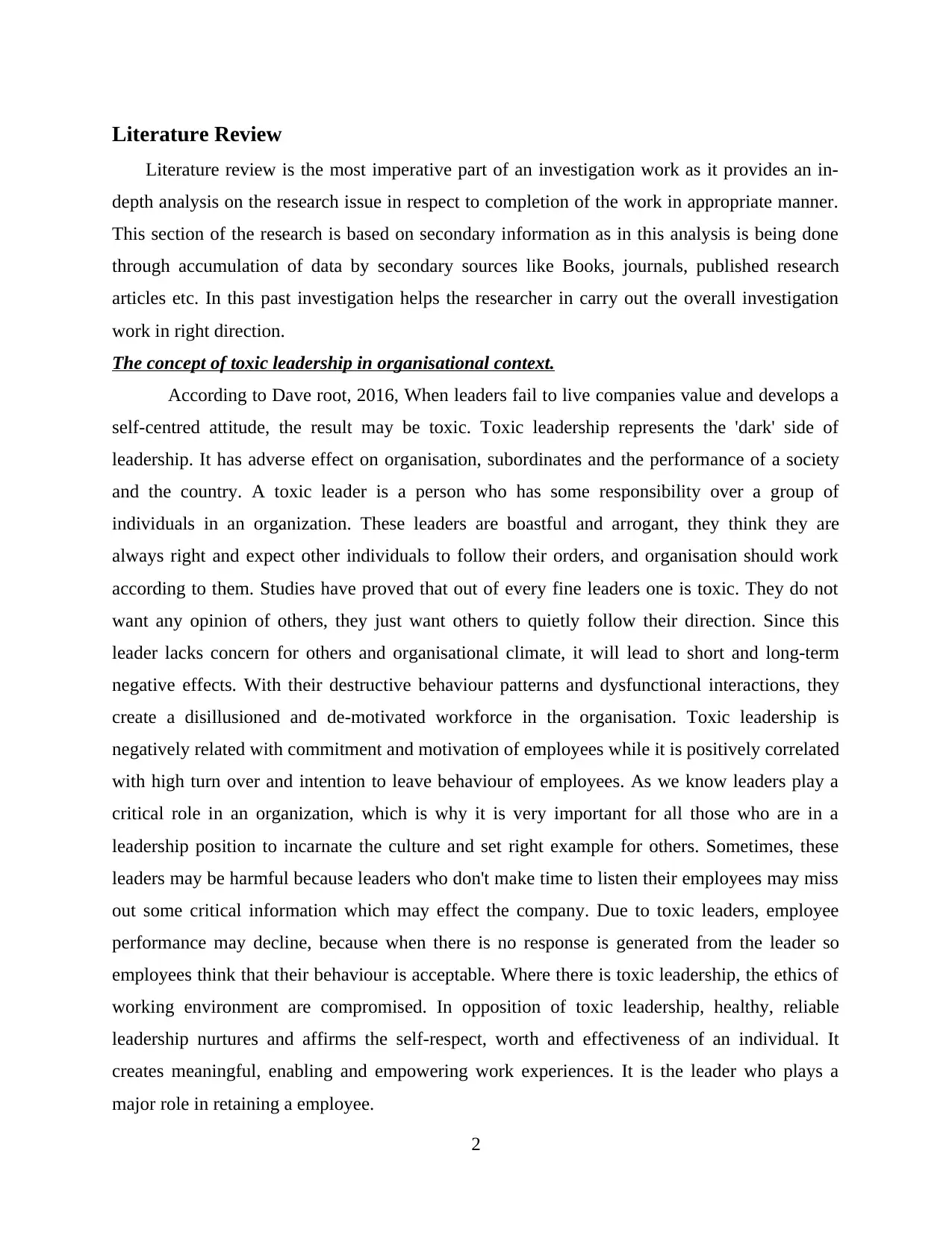
Literature Review
Literature review is the most imperative part of an investigation work as it provides an in-
depth analysis on the research issue in respect to completion of the work in appropriate manner.
This section of the research is based on secondary information as in this analysis is being done
through accumulation of data by secondary sources like Books, journals, published research
articles etc. In this past investigation helps the researcher in carry out the overall investigation
work in right direction.
The concept of toxic leadership in organisational context.
According to Dave root, 2016, When leaders fail to live companies value and develops a
self-centred attitude, the result may be toxic. Toxic leadership represents the 'dark' side of
leadership. It has adverse effect on organisation, subordinates and the performance of a society
and the country. A toxic leader is a person who has some responsibility over a group of
individuals in an organization. These leaders are boastful and arrogant, they think they are
always right and expect other individuals to follow their orders, and organisation should work
according to them. Studies have proved that out of every fine leaders one is toxic. They do not
want any opinion of others, they just want others to quietly follow their direction. Since this
leader lacks concern for others and organisational climate, it will lead to short and long-term
negative effects. With their destructive behaviour patterns and dysfunctional interactions, they
create a disillusioned and de-motivated workforce in the organisation. Toxic leadership is
negatively related with commitment and motivation of employees while it is positively correlated
with high turn over and intention to leave behaviour of employees. As we know leaders play a
critical role in an organization, which is why it is very important for all those who are in a
leadership position to incarnate the culture and set right example for others. Sometimes, these
leaders may be harmful because leaders who don't make time to listen their employees may miss
out some critical information which may effect the company. Due to toxic leaders, employee
performance may decline, because when there is no response is generated from the leader so
employees think that their behaviour is acceptable. Where there is toxic leadership, the ethics of
working environment are compromised. In opposition of toxic leadership, healthy, reliable
leadership nurtures and affirms the self-respect, worth and effectiveness of an individual. It
creates meaningful, enabling and empowering work experiences. It is the leader who plays a
major role in retaining a employee.
2
Literature review is the most imperative part of an investigation work as it provides an in-
depth analysis on the research issue in respect to completion of the work in appropriate manner.
This section of the research is based on secondary information as in this analysis is being done
through accumulation of data by secondary sources like Books, journals, published research
articles etc. In this past investigation helps the researcher in carry out the overall investigation
work in right direction.
The concept of toxic leadership in organisational context.
According to Dave root, 2016, When leaders fail to live companies value and develops a
self-centred attitude, the result may be toxic. Toxic leadership represents the 'dark' side of
leadership. It has adverse effect on organisation, subordinates and the performance of a society
and the country. A toxic leader is a person who has some responsibility over a group of
individuals in an organization. These leaders are boastful and arrogant, they think they are
always right and expect other individuals to follow their orders, and organisation should work
according to them. Studies have proved that out of every fine leaders one is toxic. They do not
want any opinion of others, they just want others to quietly follow their direction. Since this
leader lacks concern for others and organisational climate, it will lead to short and long-term
negative effects. With their destructive behaviour patterns and dysfunctional interactions, they
create a disillusioned and de-motivated workforce in the organisation. Toxic leadership is
negatively related with commitment and motivation of employees while it is positively correlated
with high turn over and intention to leave behaviour of employees. As we know leaders play a
critical role in an organization, which is why it is very important for all those who are in a
leadership position to incarnate the culture and set right example for others. Sometimes, these
leaders may be harmful because leaders who don't make time to listen their employees may miss
out some critical information which may effect the company. Due to toxic leaders, employee
performance may decline, because when there is no response is generated from the leader so
employees think that their behaviour is acceptable. Where there is toxic leadership, the ethics of
working environment are compromised. In opposition of toxic leadership, healthy, reliable
leadership nurtures and affirms the self-respect, worth and effectiveness of an individual. It
creates meaningful, enabling and empowering work experiences. It is the leader who plays a
major role in retaining a employee.
2
Paraphrase This Document
Need a fresh take? Get an instant paraphrase of this document with our AI Paraphraser
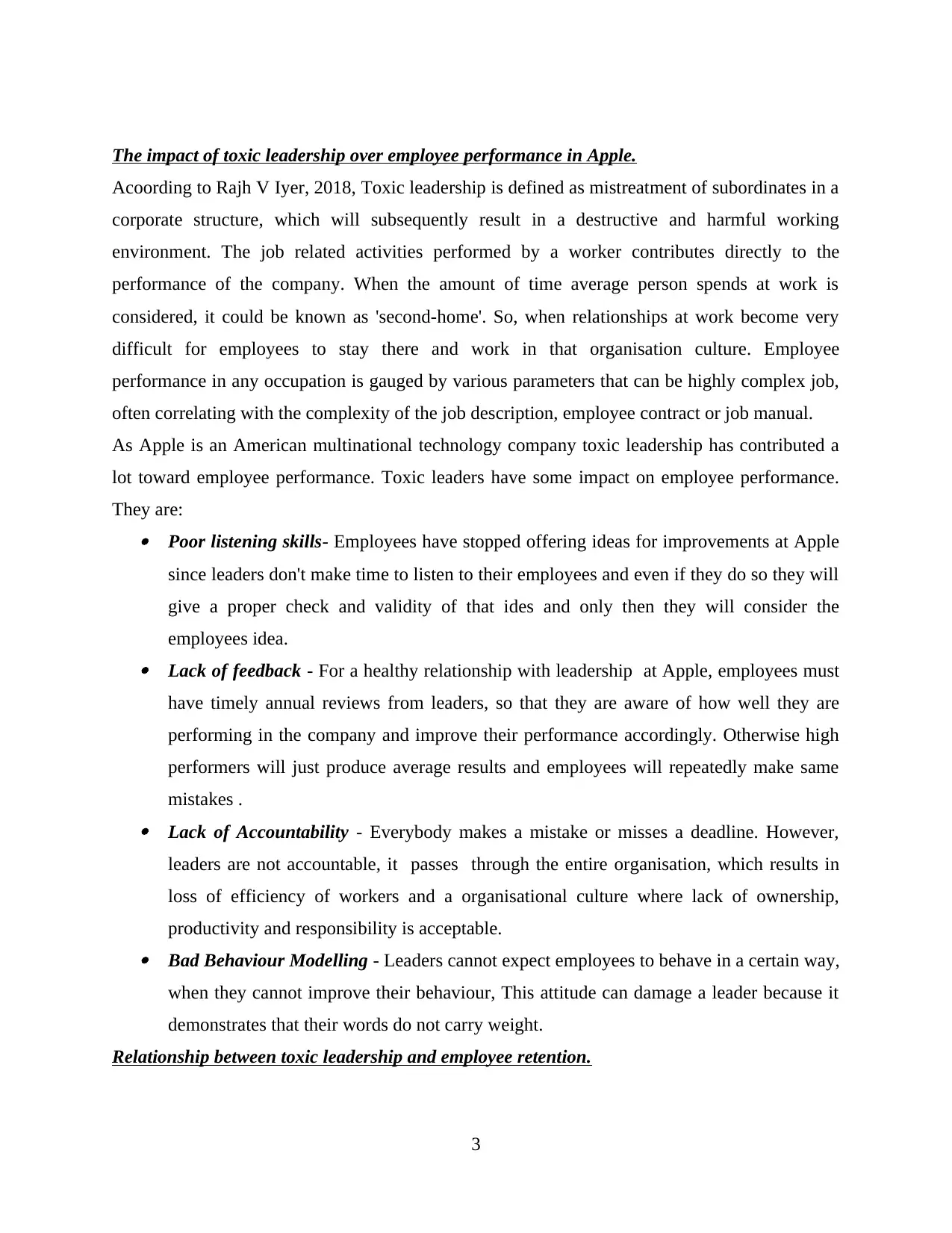
The impact of toxic leadership over employee performance in Apple.
Acoording to Rajh V Iyer, 2018, Toxic leadership is defined as mistreatment of subordinates in a
corporate structure, which will subsequently result in a destructive and harmful working
environment. The job related activities performed by a worker contributes directly to the
performance of the company. When the amount of time average person spends at work is
considered, it could be known as 'second-home'. So, when relationships at work become very
difficult for employees to stay there and work in that organisation culture. Employee
performance in any occupation is gauged by various parameters that can be highly complex job,
often correlating with the complexity of the job description, employee contract or job manual.
As Apple is an American multinational technology company toxic leadership has contributed a
lot toward employee performance. Toxic leaders have some impact on employee performance.
They are: Poor listening skills- Employees have stopped offering ideas for improvements at Apple
since leaders don't make time to listen to their employees and even if they do so they will
give a proper check and validity of that ides and only then they will consider the
employees idea. Lack of feedback - For a healthy relationship with leadership at Apple, employees must
have timely annual reviews from leaders, so that they are aware of how well they are
performing in the company and improve their performance accordingly. Otherwise high
performers will just produce average results and employees will repeatedly make same
mistakes . Lack of Accountability - Everybody makes a mistake or misses a deadline. However,
leaders are not accountable, it passes through the entire organisation, which results in
loss of efficiency of workers and a organisational culture where lack of ownership,
productivity and responsibility is acceptable. Bad Behaviour Modelling - Leaders cannot expect employees to behave in a certain way,
when they cannot improve their behaviour, This attitude can damage a leader because it
demonstrates that their words do not carry weight.
Relationship between toxic leadership and employee retention.
3
Acoording to Rajh V Iyer, 2018, Toxic leadership is defined as mistreatment of subordinates in a
corporate structure, which will subsequently result in a destructive and harmful working
environment. The job related activities performed by a worker contributes directly to the
performance of the company. When the amount of time average person spends at work is
considered, it could be known as 'second-home'. So, when relationships at work become very
difficult for employees to stay there and work in that organisation culture. Employee
performance in any occupation is gauged by various parameters that can be highly complex job,
often correlating with the complexity of the job description, employee contract or job manual.
As Apple is an American multinational technology company toxic leadership has contributed a
lot toward employee performance. Toxic leaders have some impact on employee performance.
They are: Poor listening skills- Employees have stopped offering ideas for improvements at Apple
since leaders don't make time to listen to their employees and even if they do so they will
give a proper check and validity of that ides and only then they will consider the
employees idea. Lack of feedback - For a healthy relationship with leadership at Apple, employees must
have timely annual reviews from leaders, so that they are aware of how well they are
performing in the company and improve their performance accordingly. Otherwise high
performers will just produce average results and employees will repeatedly make same
mistakes . Lack of Accountability - Everybody makes a mistake or misses a deadline. However,
leaders are not accountable, it passes through the entire organisation, which results in
loss of efficiency of workers and a organisational culture where lack of ownership,
productivity and responsibility is acceptable. Bad Behaviour Modelling - Leaders cannot expect employees to behave in a certain way,
when they cannot improve their behaviour, This attitude can damage a leader because it
demonstrates that their words do not carry weight.
Relationship between toxic leadership and employee retention.
3
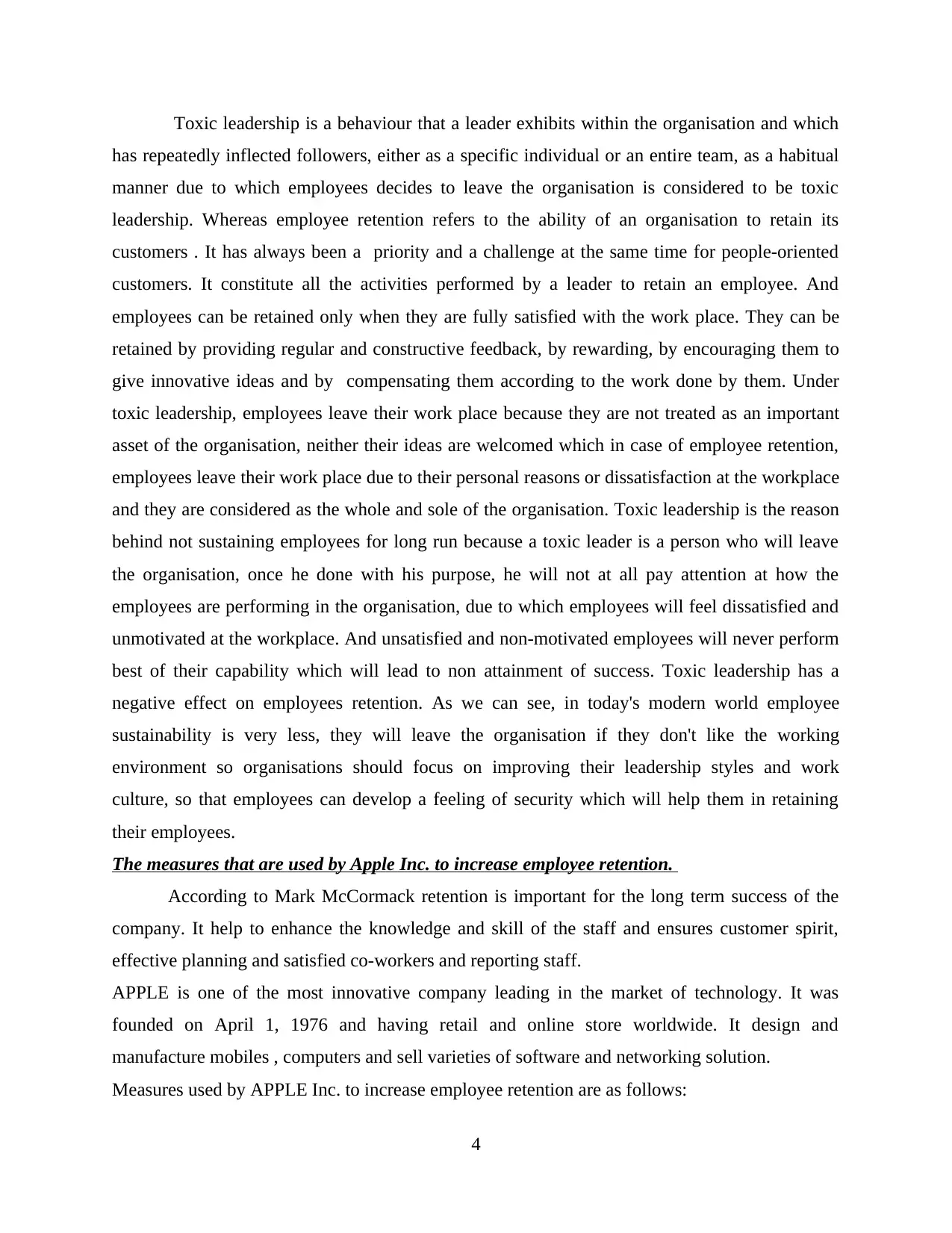
Toxic leadership is a behaviour that a leader exhibits within the organisation and which
has repeatedly inflected followers, either as a specific individual or an entire team, as a habitual
manner due to which employees decides to leave the organisation is considered to be toxic
leadership. Whereas employee retention refers to the ability of an organisation to retain its
customers . It has always been a priority and a challenge at the same time for people-oriented
customers. It constitute all the activities performed by a leader to retain an employee. And
employees can be retained only when they are fully satisfied with the work place. They can be
retained by providing regular and constructive feedback, by rewarding, by encouraging them to
give innovative ideas and by compensating them according to the work done by them. Under
toxic leadership, employees leave their work place because they are not treated as an important
asset of the organisation, neither their ideas are welcomed which in case of employee retention,
employees leave their work place due to their personal reasons or dissatisfaction at the workplace
and they are considered as the whole and sole of the organisation. Toxic leadership is the reason
behind not sustaining employees for long run because a toxic leader is a person who will leave
the organisation, once he done with his purpose, he will not at all pay attention at how the
employees are performing in the organisation, due to which employees will feel dissatisfied and
unmotivated at the workplace. And unsatisfied and non-motivated employees will never perform
best of their capability which will lead to non attainment of success. Toxic leadership has a
negative effect on employees retention. As we can see, in today's modern world employee
sustainability is very less, they will leave the organisation if they don't like the working
environment so organisations should focus on improving their leadership styles and work
culture, so that employees can develop a feeling of security which will help them in retaining
their employees.
The measures that are used by Apple Inc. to increase employee retention.
According to Mark McCormack retention is important for the long term success of the
company. It help to enhance the knowledge and skill of the staff and ensures customer spirit,
effective planning and satisfied co-workers and reporting staff.
APPLE is one of the most innovative company leading in the market of technology. It was
founded on April 1, 1976 and having retail and online store worldwide. It design and
manufacture mobiles , computers and sell varieties of software and networking solution.
Measures used by APPLE Inc. to increase employee retention are as follows:
4
has repeatedly inflected followers, either as a specific individual or an entire team, as a habitual
manner due to which employees decides to leave the organisation is considered to be toxic
leadership. Whereas employee retention refers to the ability of an organisation to retain its
customers . It has always been a priority and a challenge at the same time for people-oriented
customers. It constitute all the activities performed by a leader to retain an employee. And
employees can be retained only when they are fully satisfied with the work place. They can be
retained by providing regular and constructive feedback, by rewarding, by encouraging them to
give innovative ideas and by compensating them according to the work done by them. Under
toxic leadership, employees leave their work place because they are not treated as an important
asset of the organisation, neither their ideas are welcomed which in case of employee retention,
employees leave their work place due to their personal reasons or dissatisfaction at the workplace
and they are considered as the whole and sole of the organisation. Toxic leadership is the reason
behind not sustaining employees for long run because a toxic leader is a person who will leave
the organisation, once he done with his purpose, he will not at all pay attention at how the
employees are performing in the organisation, due to which employees will feel dissatisfied and
unmotivated at the workplace. And unsatisfied and non-motivated employees will never perform
best of their capability which will lead to non attainment of success. Toxic leadership has a
negative effect on employees retention. As we can see, in today's modern world employee
sustainability is very less, they will leave the organisation if they don't like the working
environment so organisations should focus on improving their leadership styles and work
culture, so that employees can develop a feeling of security which will help them in retaining
their employees.
The measures that are used by Apple Inc. to increase employee retention.
According to Mark McCormack retention is important for the long term success of the
company. It help to enhance the knowledge and skill of the staff and ensures customer spirit,
effective planning and satisfied co-workers and reporting staff.
APPLE is one of the most innovative company leading in the market of technology. It was
founded on April 1, 1976 and having retail and online store worldwide. It design and
manufacture mobiles , computers and sell varieties of software and networking solution.
Measures used by APPLE Inc. to increase employee retention are as follows:
4
⊘ This is a preview!⊘
Do you want full access?
Subscribe today to unlock all pages.

Trusted by 1+ million students worldwide
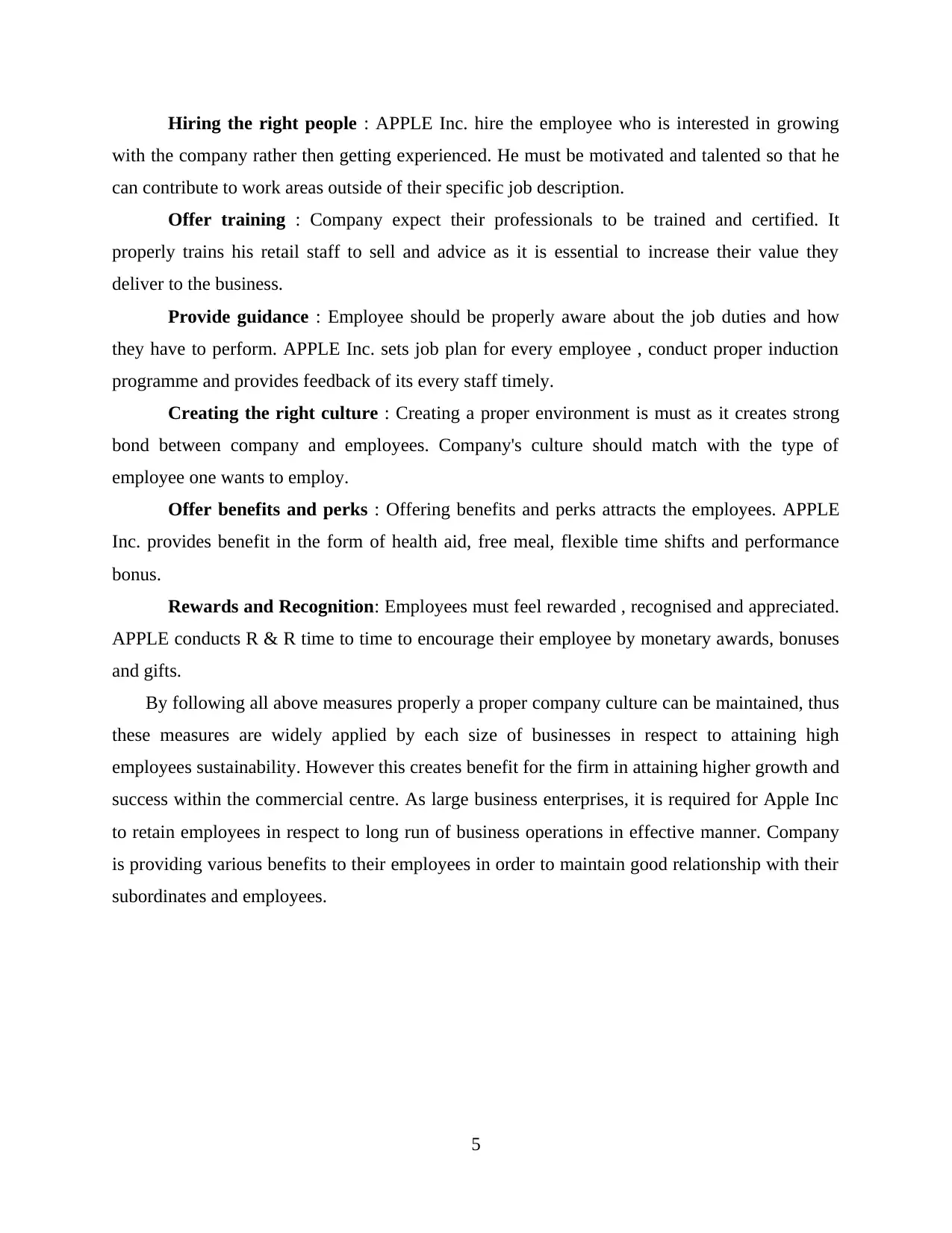
Hiring the right people : APPLE Inc. hire the employee who is interested in growing
with the company rather then getting experienced. He must be motivated and talented so that he
can contribute to work areas outside of their specific job description.
Offer training : Company expect their professionals to be trained and certified. It
properly trains his retail staff to sell and advice as it is essential to increase their value they
deliver to the business.
Provide guidance : Employee should be properly aware about the job duties and how
they have to perform. APPLE Inc. sets job plan for every employee , conduct proper induction
programme and provides feedback of its every staff timely.
Creating the right culture : Creating a proper environment is must as it creates strong
bond between company and employees. Company's culture should match with the type of
employee one wants to employ.
Offer benefits and perks : Offering benefits and perks attracts the employees. APPLE
Inc. provides benefit in the form of health aid, free meal, flexible time shifts and performance
bonus.
Rewards and Recognition: Employees must feel rewarded , recognised and appreciated.
APPLE conducts R & R time to time to encourage their employee by monetary awards, bonuses
and gifts.
By following all above measures properly a proper company culture can be maintained, thus
these measures are widely applied by each size of businesses in respect to attaining high
employees sustainability. However this creates benefit for the firm in attaining higher growth and
success within the commercial centre. As large business enterprises, it is required for Apple Inc
to retain employees in respect to long run of business operations in effective manner. Company
is providing various benefits to their employees in order to maintain good relationship with their
subordinates and employees.
5
with the company rather then getting experienced. He must be motivated and talented so that he
can contribute to work areas outside of their specific job description.
Offer training : Company expect their professionals to be trained and certified. It
properly trains his retail staff to sell and advice as it is essential to increase their value they
deliver to the business.
Provide guidance : Employee should be properly aware about the job duties and how
they have to perform. APPLE Inc. sets job plan for every employee , conduct proper induction
programme and provides feedback of its every staff timely.
Creating the right culture : Creating a proper environment is must as it creates strong
bond between company and employees. Company's culture should match with the type of
employee one wants to employ.
Offer benefits and perks : Offering benefits and perks attracts the employees. APPLE
Inc. provides benefit in the form of health aid, free meal, flexible time shifts and performance
bonus.
Rewards and Recognition: Employees must feel rewarded , recognised and appreciated.
APPLE conducts R & R time to time to encourage their employee by monetary awards, bonuses
and gifts.
By following all above measures properly a proper company culture can be maintained, thus
these measures are widely applied by each size of businesses in respect to attaining high
employees sustainability. However this creates benefit for the firm in attaining higher growth and
success within the commercial centre. As large business enterprises, it is required for Apple Inc
to retain employees in respect to long run of business operations in effective manner. Company
is providing various benefits to their employees in order to maintain good relationship with their
subordinates and employees.
5
Paraphrase This Document
Need a fresh take? Get an instant paraphrase of this document with our AI Paraphraser
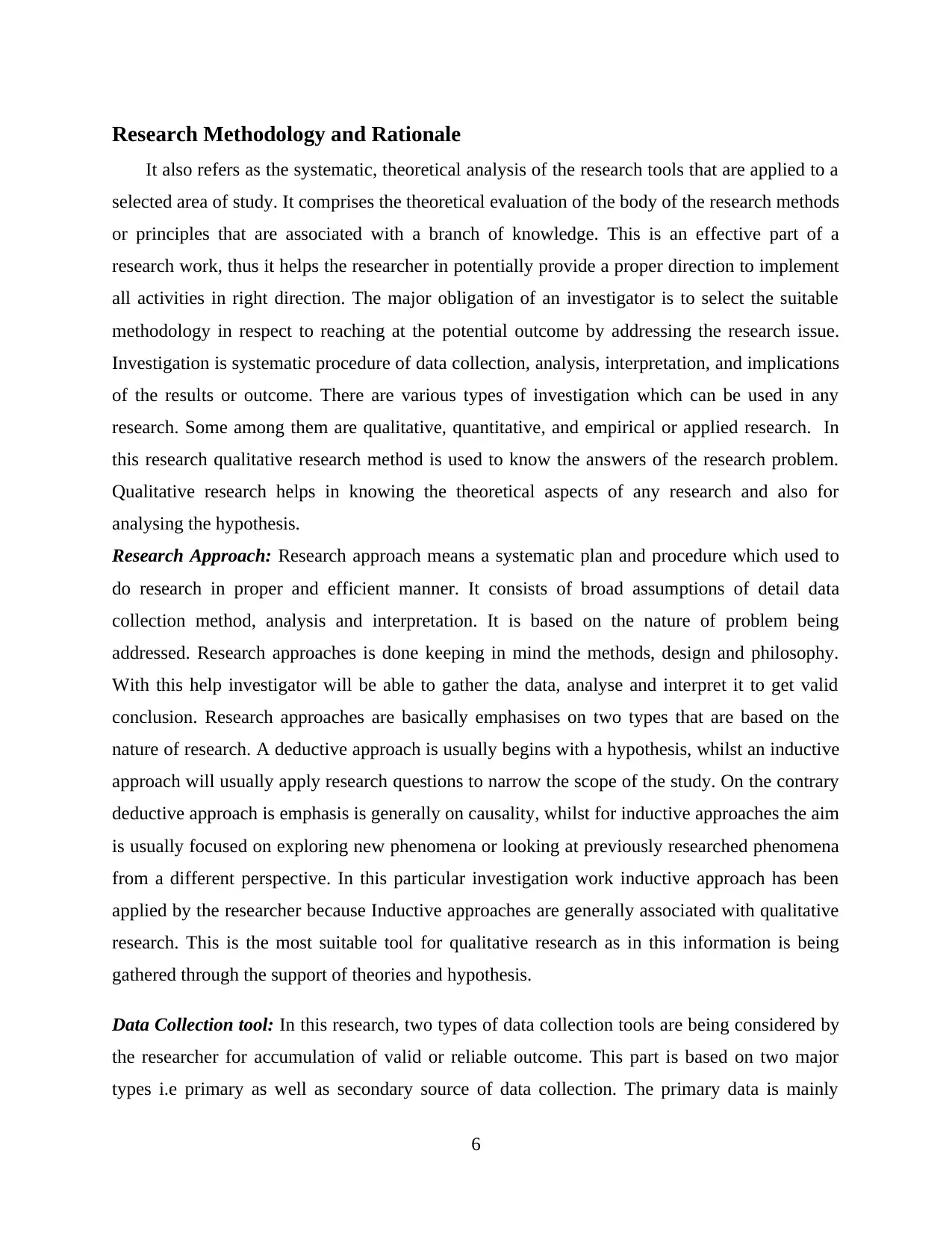
Research Methodology and Rationale
It also refers as the systematic, theoretical analysis of the research tools that are applied to a
selected area of study. It comprises the theoretical evaluation of the body of the research methods
or principles that are associated with a branch of knowledge. This is an effective part of a
research work, thus it helps the researcher in potentially provide a proper direction to implement
all activities in right direction. The major obligation of an investigator is to select the suitable
methodology in respect to reaching at the potential outcome by addressing the research issue.
Investigation is systematic procedure of data collection, analysis, interpretation, and implications
of the results or outcome. There are various types of investigation which can be used in any
research. Some among them are qualitative, quantitative, and empirical or applied research. In
this research qualitative research method is used to know the answers of the research problem.
Qualitative research helps in knowing the theoretical aspects of any research and also for
analysing the hypothesis.
Research Approach: Research approach means a systematic plan and procedure which used to
do research in proper and efficient manner. It consists of broad assumptions of detail data
collection method, analysis and interpretation. It is based on the nature of problem being
addressed. Research approaches is done keeping in mind the methods, design and philosophy.
With this help investigator will be able to gather the data, analyse and interpret it to get valid
conclusion. Research approaches are basically emphasises on two types that are based on the
nature of research. A deductive approach is usually begins with a hypothesis, whilst an inductive
approach will usually apply research questions to narrow the scope of the study. On the contrary
deductive approach is emphasis is generally on causality, whilst for inductive approaches the aim
is usually focused on exploring new phenomena or looking at previously researched phenomena
from a different perspective. In this particular investigation work inductive approach has been
applied by the researcher because Inductive approaches are generally associated with qualitative
research. This is the most suitable tool for qualitative research as in this information is being
gathered through the support of theories and hypothesis.
Data Collection tool: In this research, two types of data collection tools are being considered by
the researcher for accumulation of valid or reliable outcome. This part is based on two major
types i.e primary as well as secondary source of data collection. The primary data is mainly
6
It also refers as the systematic, theoretical analysis of the research tools that are applied to a
selected area of study. It comprises the theoretical evaluation of the body of the research methods
or principles that are associated with a branch of knowledge. This is an effective part of a
research work, thus it helps the researcher in potentially provide a proper direction to implement
all activities in right direction. The major obligation of an investigator is to select the suitable
methodology in respect to reaching at the potential outcome by addressing the research issue.
Investigation is systematic procedure of data collection, analysis, interpretation, and implications
of the results or outcome. There are various types of investigation which can be used in any
research. Some among them are qualitative, quantitative, and empirical or applied research. In
this research qualitative research method is used to know the answers of the research problem.
Qualitative research helps in knowing the theoretical aspects of any research and also for
analysing the hypothesis.
Research Approach: Research approach means a systematic plan and procedure which used to
do research in proper and efficient manner. It consists of broad assumptions of detail data
collection method, analysis and interpretation. It is based on the nature of problem being
addressed. Research approaches is done keeping in mind the methods, design and philosophy.
With this help investigator will be able to gather the data, analyse and interpret it to get valid
conclusion. Research approaches are basically emphasises on two types that are based on the
nature of research. A deductive approach is usually begins with a hypothesis, whilst an inductive
approach will usually apply research questions to narrow the scope of the study. On the contrary
deductive approach is emphasis is generally on causality, whilst for inductive approaches the aim
is usually focused on exploring new phenomena or looking at previously researched phenomena
from a different perspective. In this particular investigation work inductive approach has been
applied by the researcher because Inductive approaches are generally associated with qualitative
research. This is the most suitable tool for qualitative research as in this information is being
gathered through the support of theories and hypothesis.
Data Collection tool: In this research, two types of data collection tools are being considered by
the researcher for accumulation of valid or reliable outcome. This part is based on two major
types i.e primary as well as secondary source of data collection. The primary data is mainly
6
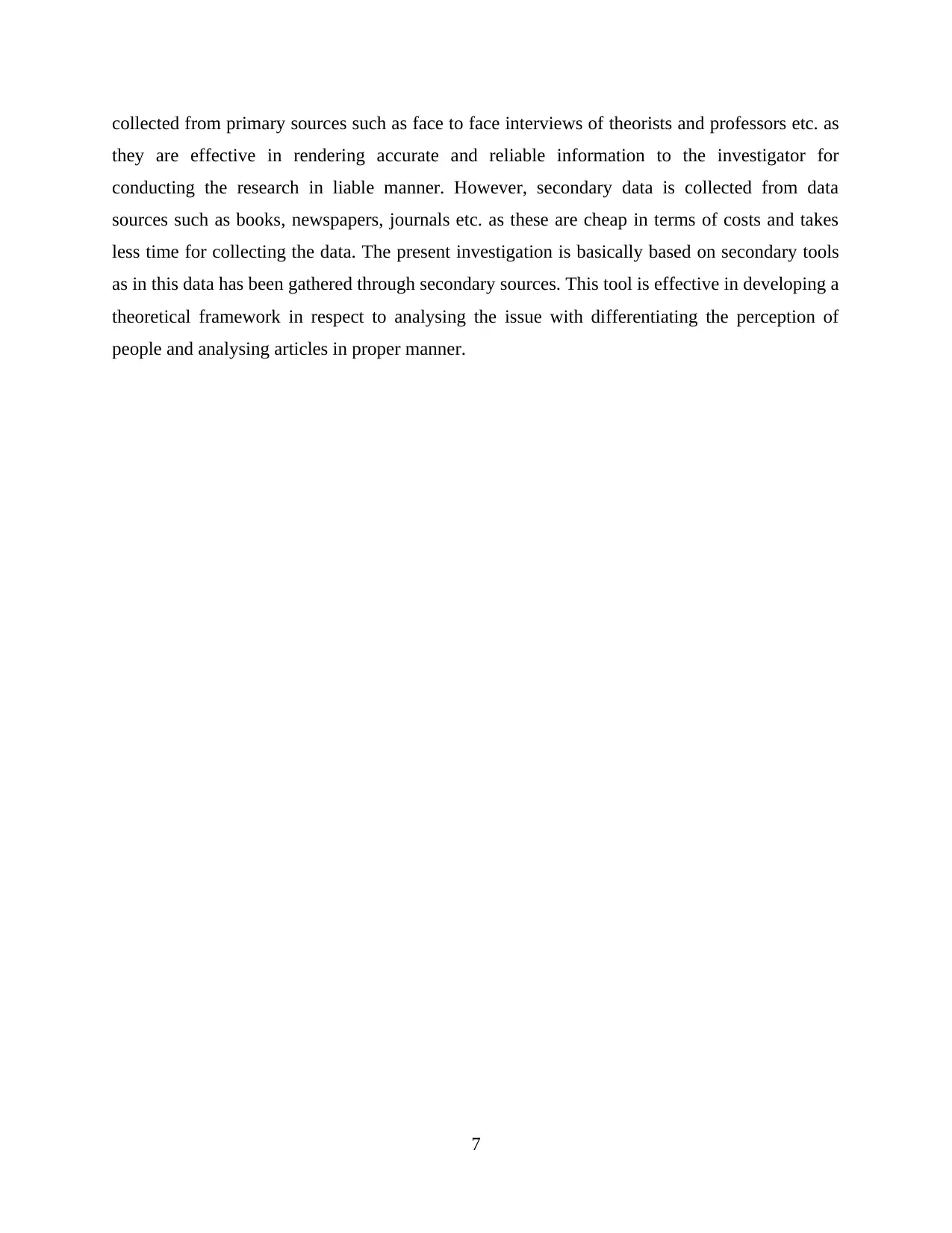
collected from primary sources such as face to face interviews of theorists and professors etc. as
they are effective in rendering accurate and reliable information to the investigator for
conducting the research in liable manner. However, secondary data is collected from data
sources such as books, newspapers, journals etc. as these are cheap in terms of costs and takes
less time for collecting the data. The present investigation is basically based on secondary tools
as in this data has been gathered through secondary sources. This tool is effective in developing a
theoretical framework in respect to analysing the issue with differentiating the perception of
people and analysing articles in proper manner.
7
they are effective in rendering accurate and reliable information to the investigator for
conducting the research in liable manner. However, secondary data is collected from data
sources such as books, newspapers, journals etc. as these are cheap in terms of costs and takes
less time for collecting the data. The present investigation is basically based on secondary tools
as in this data has been gathered through secondary sources. This tool is effective in developing a
theoretical framework in respect to analysing the issue with differentiating the perception of
people and analysing articles in proper manner.
7
⊘ This is a preview!⊘
Do you want full access?
Subscribe today to unlock all pages.

Trusted by 1+ million students worldwide
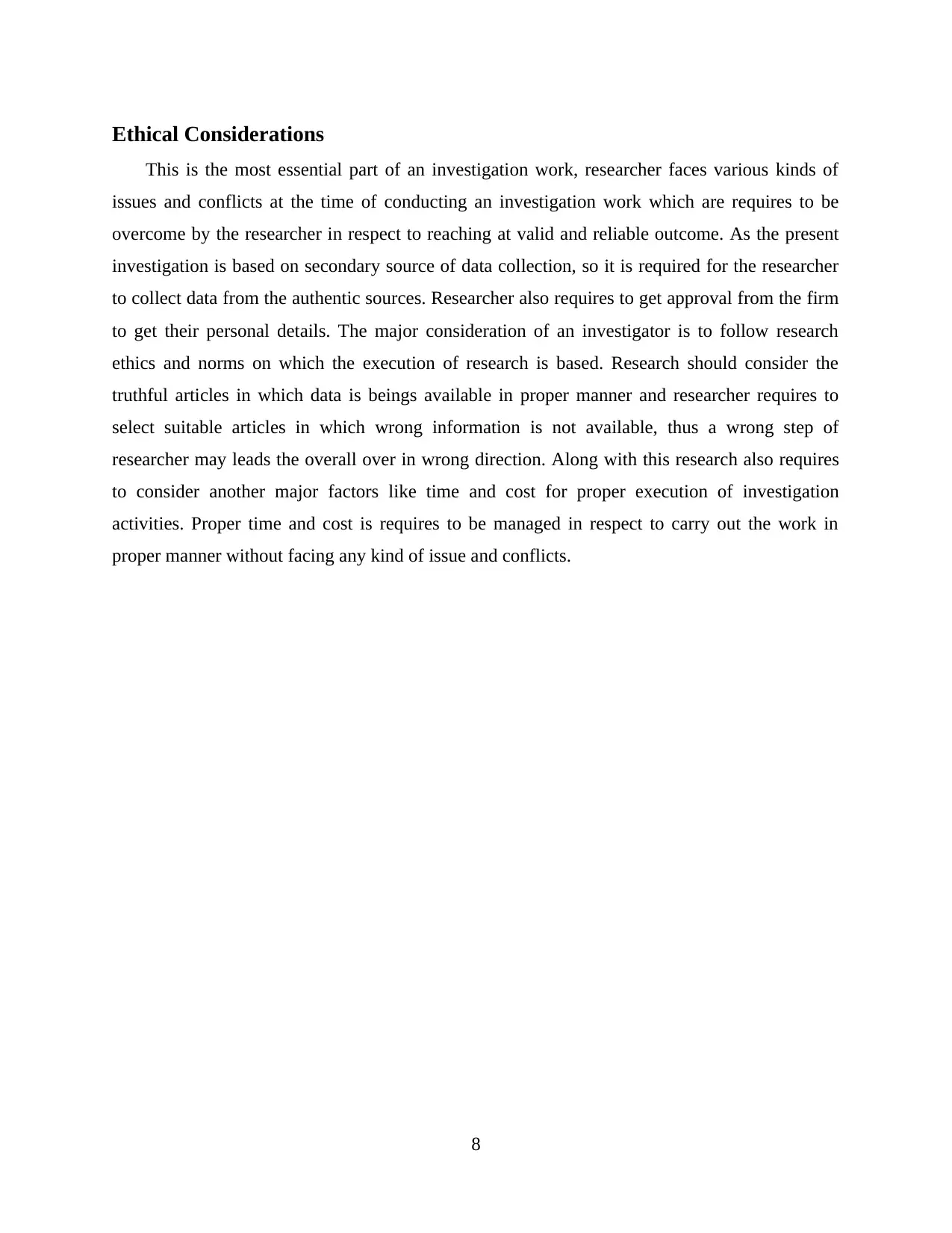
Ethical Considerations
This is the most essential part of an investigation work, researcher faces various kinds of
issues and conflicts at the time of conducting an investigation work which are requires to be
overcome by the researcher in respect to reaching at valid and reliable outcome. As the present
investigation is based on secondary source of data collection, so it is required for the researcher
to collect data from the authentic sources. Researcher also requires to get approval from the firm
to get their personal details. The major consideration of an investigator is to follow research
ethics and norms on which the execution of research is based. Research should consider the
truthful articles in which data is beings available in proper manner and researcher requires to
select suitable articles in which wrong information is not available, thus a wrong step of
researcher may leads the overall over in wrong direction. Along with this research also requires
to consider another major factors like time and cost for proper execution of investigation
activities. Proper time and cost is requires to be managed in respect to carry out the work in
proper manner without facing any kind of issue and conflicts.
8
This is the most essential part of an investigation work, researcher faces various kinds of
issues and conflicts at the time of conducting an investigation work which are requires to be
overcome by the researcher in respect to reaching at valid and reliable outcome. As the present
investigation is based on secondary source of data collection, so it is required for the researcher
to collect data from the authentic sources. Researcher also requires to get approval from the firm
to get their personal details. The major consideration of an investigator is to follow research
ethics and norms on which the execution of research is based. Research should consider the
truthful articles in which data is beings available in proper manner and researcher requires to
select suitable articles in which wrong information is not available, thus a wrong step of
researcher may leads the overall over in wrong direction. Along with this research also requires
to consider another major factors like time and cost for proper execution of investigation
activities. Proper time and cost is requires to be managed in respect to carry out the work in
proper manner without facing any kind of issue and conflicts.
8
Paraphrase This Document
Need a fresh take? Get an instant paraphrase of this document with our AI Paraphraser
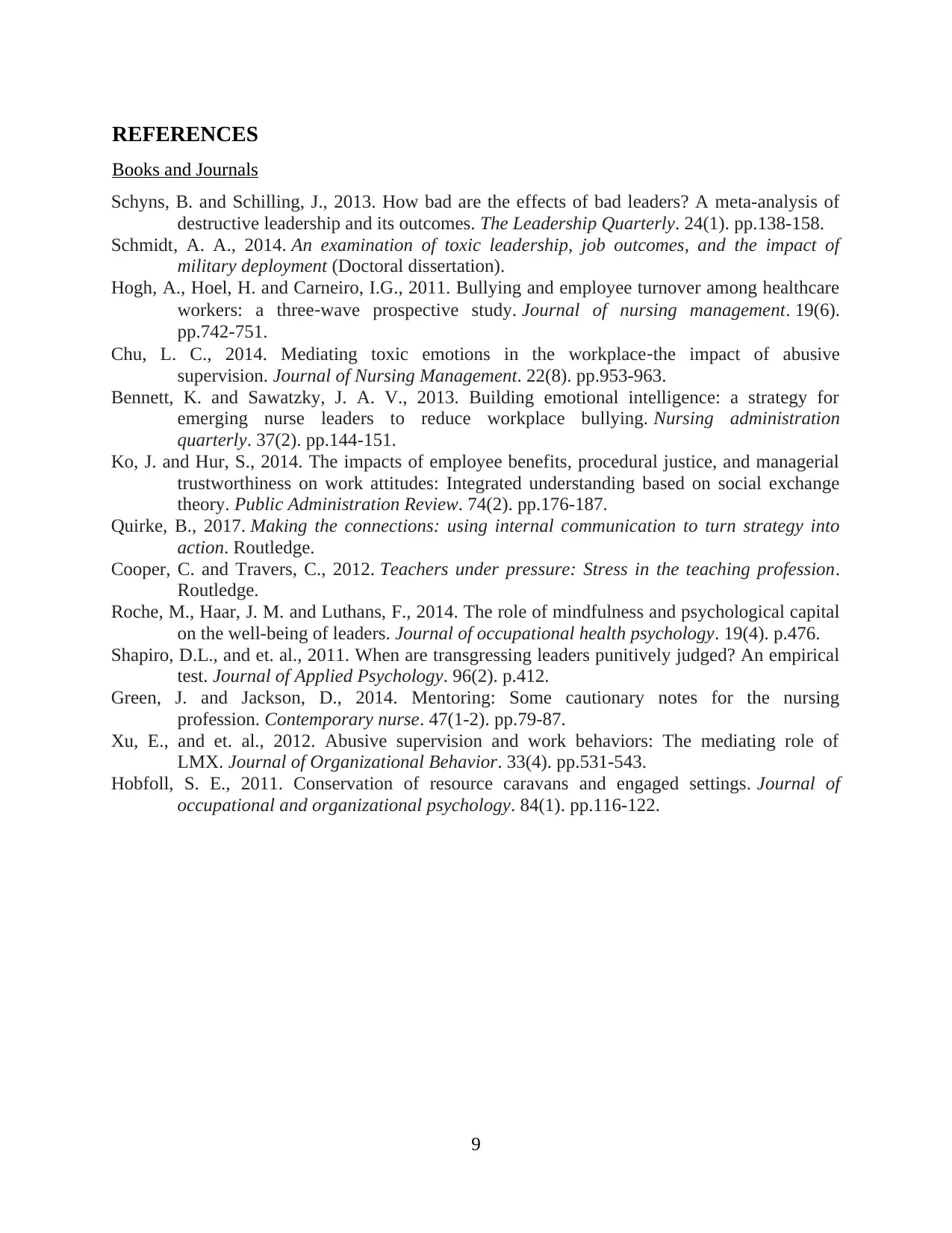
REFERENCES
Books and Journals
Schyns, B. and Schilling, J., 2013. How bad are the effects of bad leaders? A meta-analysis of
destructive leadership and its outcomes. The Leadership Quarterly. 24(1). pp.138-158.
Schmidt, A. A., 2014. An examination of toxic leadership, job outcomes, and the impact of
military deployment (Doctoral dissertation).
Hogh, A., Hoel, H. and Carneiro, I.G., 2011. Bullying and employee turnover among healthcare
workers: a three‐wave prospective study. Journal of nursing management. 19(6).
pp.742-751.
Chu, L. C., 2014. Mediating toxic emotions in the workplace‐the impact of abusive
supervision. Journal of Nursing Management. 22(8). pp.953-963.
Bennett, K. and Sawatzky, J. A. V., 2013. Building emotional intelligence: a strategy for
emerging nurse leaders to reduce workplace bullying. Nursing administration
quarterly. 37(2). pp.144-151.
Ko, J. and Hur, S., 2014. The impacts of employee benefits, procedural justice, and managerial
trustworthiness on work attitudes: Integrated understanding based on social exchange
theory. Public Administration Review. 74(2). pp.176-187.
Quirke, B., 2017. Making the connections: using internal communication to turn strategy into
action. Routledge.
Cooper, C. and Travers, C., 2012. Teachers under pressure: Stress in the teaching profession.
Routledge.
Roche, M., Haar, J. M. and Luthans, F., 2014. The role of mindfulness and psychological capital
on the well-being of leaders. Journal of occupational health psychology. 19(4). p.476.
Shapiro, D.L., and et. al., 2011. When are transgressing leaders punitively judged? An empirical
test. Journal of Applied Psychology. 96(2). p.412.
Green, J. and Jackson, D., 2014. Mentoring: Some cautionary notes for the nursing
profession. Contemporary nurse. 47(1-2). pp.79-87.
Xu, E., and et. al., 2012. Abusive supervision and work behaviors: The mediating role of
LMX. Journal of Organizational Behavior. 33(4). pp.531-543.
Hobfoll, S. E., 2011. Conservation of resource caravans and engaged settings. Journal of
occupational and organizational psychology. 84(1). pp.116-122.
9
Books and Journals
Schyns, B. and Schilling, J., 2013. How bad are the effects of bad leaders? A meta-analysis of
destructive leadership and its outcomes. The Leadership Quarterly. 24(1). pp.138-158.
Schmidt, A. A., 2014. An examination of toxic leadership, job outcomes, and the impact of
military deployment (Doctoral dissertation).
Hogh, A., Hoel, H. and Carneiro, I.G., 2011. Bullying and employee turnover among healthcare
workers: a three‐wave prospective study. Journal of nursing management. 19(6).
pp.742-751.
Chu, L. C., 2014. Mediating toxic emotions in the workplace‐the impact of abusive
supervision. Journal of Nursing Management. 22(8). pp.953-963.
Bennett, K. and Sawatzky, J. A. V., 2013. Building emotional intelligence: a strategy for
emerging nurse leaders to reduce workplace bullying. Nursing administration
quarterly. 37(2). pp.144-151.
Ko, J. and Hur, S., 2014. The impacts of employee benefits, procedural justice, and managerial
trustworthiness on work attitudes: Integrated understanding based on social exchange
theory. Public Administration Review. 74(2). pp.176-187.
Quirke, B., 2017. Making the connections: using internal communication to turn strategy into
action. Routledge.
Cooper, C. and Travers, C., 2012. Teachers under pressure: Stress in the teaching profession.
Routledge.
Roche, M., Haar, J. M. and Luthans, F., 2014. The role of mindfulness and psychological capital
on the well-being of leaders. Journal of occupational health psychology. 19(4). p.476.
Shapiro, D.L., and et. al., 2011. When are transgressing leaders punitively judged? An empirical
test. Journal of Applied Psychology. 96(2). p.412.
Green, J. and Jackson, D., 2014. Mentoring: Some cautionary notes for the nursing
profession. Contemporary nurse. 47(1-2). pp.79-87.
Xu, E., and et. al., 2012. Abusive supervision and work behaviors: The mediating role of
LMX. Journal of Organizational Behavior. 33(4). pp.531-543.
Hobfoll, S. E., 2011. Conservation of resource caravans and engaged settings. Journal of
occupational and organizational psychology. 84(1). pp.116-122.
9
1 out of 11
Related Documents
Your All-in-One AI-Powered Toolkit for Academic Success.
+13062052269
info@desklib.com
Available 24*7 on WhatsApp / Email
![[object Object]](/_next/static/media/star-bottom.7253800d.svg)
Unlock your academic potential
Copyright © 2020–2025 A2Z Services. All Rights Reserved. Developed and managed by ZUCOL.





